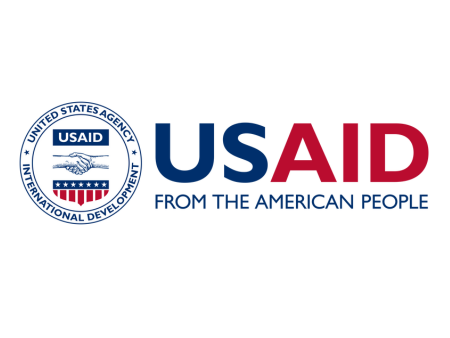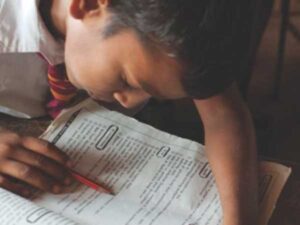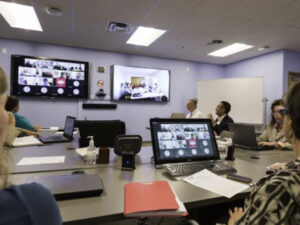The U.S. Agency for International Development (USAID) is an independent agency of the United States government that is primarily responsible for administering civilian foreign aid and development assistance.
Gillian Caldwell of the United States Agency for International Development (USAID) spoke with Lissa Harris on February 12, 2024. Click here to read the full interview with insights highlighted.
Lissa Harris: Can you start by introducing yourself, your organization, and talk about the problem that you’re tackling and how you’re trying to solve it.
Gillian Caldwell: My name is Gillian Caldwell, and I serve as the Chief Climate Officer at the U.S. Agency for International Development (USAID). I’m also a Deputy Assistant Administrator overseeing a range of work from land and resource governance, ocean plastics and pollution, urbanization, renewable energy and biodiversity.
USAID is the largest development aid agency in the world; we are the US government’s delivery mechanism for aid. Aid encompasses global health interventions around malaria, HIV/AIDS, and other infectious diseases as well as humanitarian intervention in places that are suffering from extreme weather events and/or conflict. We also have programs on democracy rights, governance, education and more. My focus is on climate.
Lissa Harris: Who are the folks that you are directly serving? Is it mostly NGOs on the ground who are doing frontline work? Who benefits from your work and how do you engage with them?
Gillian Caldwell: We’re working in lower- and middle-income countries in Africa, Latin America, and Asia. We do our work through partnership with local and international NGOs as well as other businesses and organizations. The focus of the work is on trying to address poverty and advance sustainable economic development, so the people benefiting are people who are impoverished in many developing economies around the world.
Lissa Harris: Is there a typical way that you engage with your partners or reach out to them, or do they reach out to you?
Gillian Caldwell: We call them implementing partners. We tend to sign fairly large contracts — in the many millions of dollars — for people to advance a particular body of work. There’s competitive procurement: we’ll put out a request for proposals and review a range of applications.
One of the things that we’re working on is trying to localize our investments because historically the investments have gone to — because of the size of the grants and the challenge of submitting a successful bid and doing the monitoring and evaluation required — to go to the larger US-based entities.
Lissa Harris: How do the organizations that you’re working with benefit other than receiving financial assistance?
Gillian Caldwell: Some are directly serving as the implementing partners, and that’s the ideal circumstance. In other situations, they’re getting passed through grants from a larger entity like a Save the Children or a World Wildlife Fund. Over time, the idea is that it will build their capacity to enable them to apply for and manage larger grants.
Lissa Harris: What makes your approach distinctive from other organizations or government entities working in this space?
Gillian Caldwell: One of the things we’re really pushing is public-private partnership, specifically in the context of climate finance, where there’s a yawning gap between the funding that’s been made available through governments globally and the funding that’s required — which is projected to be $3-5 trillion a year by 2030 for mitigation, reducing emissions, and adapting to the consequences of the crisis. We can’t get where we need to go without increasing private sector partnerships.
USAID is innovating ways to use concessional public finance to set the stage for private sector investment by providing something akin to first loss guarantees or the kind of the base of the pyramid that reduces risk for private sector investment in either adaptation or mitigation.
Lissa Harris: Is there an example or a story that you like to tell that shows the impact of the work that you do?
Gillian Caldwell: When we talk about catalyzing private sector investment, it’s often our work in the area of renewable energy auctions. We’ve been perfecting the art of shaping competitive transparent auctions to procure renewable energy.
For example, a government might want to make the transition — perhaps their commitments under the Paris agreement or just given their commitment to sustainability — and want to expand the amount of renewable energy coming off their grid; we help them shape an energy auction that will crowd in a range of investors who are bidding to deliver that renewable energy.
That way, the government will get a predictable and affordable price over time; businesses — including businesses in the US — get an opportunity to bid for that business in a way that’s open and transparent.
That work has actually helped set the stage for over 10% of the renewable energy growth in the world globally. So very, very high impact.
Lissa Harris: What do you think the insights or the teachable lessons are that can be taken from your work that others in the space could use?
Gillian Caldwell: I’m a long-time environmental and human rights advocate, and I’ve been in non-governmental organizations throughout my career; my takeaway here is that if you really want to be effective as an advocate, you should spend some time inside government.
It’s a different vantage point, and there’s also so much more leverage. The agency has a budget of 30 to 50 billion dollars a year. When you compare that to the budgets of much smaller social enterprises, there’s just a lot more room to roam, and I think not enough social entrepreneurs consider time in government.
Lissa Harris: How do you measure success? What are the metrics or the evidence that you look to see that you are making progress towards your goals?
Gillian Caldwell: We have concrete outcomes that we’re aiming to achieve by 2030 under our climate strategy.
One is reducing carbon emissions by six billion metric tons. That’s about one and a half times all U.S. emissions in 2021. In order to do that, a lot of it will be through natural climate solutions, specifically keeping forests standing and preserving other carbon critical landscapes.
We also have a goal to preserve 100 million hectares of carbon critical landscape. We want to reach half a billion people worldwide with increased adaptation and resilience. We have a big emphasis on early warning systems, which are important not just in terms of extreme weather events, but also in terms of informing small holder farmers as to when to plant or harvest, given the vagaries of the weather these days.
Then, we have a goal to catalyze $150 billion in public and private finance by 2030.
And finally, we’re aiming to support all 80 countries that we have offices in to deliver on their Paris commitments.
Those are the primary metrics by which we evaluate our progress.
Lissa Harris: Sometimes in social change, people learn as much from things that don’t work as things that do. Is there something that you can describe that you tried that didn’t work, but that you learned something from in a way that others might also?
Gillian Caldwell: The biggest lesson learned [from my time in government] has to do with our commitment to localization and to really deepening our investment in local communities. You really can’t advance sustainable development without those investments — without ensuring a robust civil society at a local level. You can’t underestimate the amount of time and resources you have to invest in order to make that possible.
Lissa Harris: Is there a specific example that you can point to of a specific challenge? Or is there something like a specific story you can tell there?
Gillian Caldwell: Not so much a story as an example of a challenge.
There’s a pledge that was made at COP26 [26th United Nation Conference of Parties] in Glasgow. During the UN negotiations in Glasgow in 2021, governments and donors pledged to contribute $1.6 billion to indigenous people in local communities.
While the numbers are adding up and we would appear to be on target to achieve that goal within, I think the five-year timeframe that was committed — if you actually analyze the support and where it’s going — not enough is going directly to those indigenous people in local communities.
It points to this ongoing problem. There’s a chicken and egg dimension to it: these organizations don’t have, in many cases, the capacity to prepare and deliver a winning proposal and navigate the bureaucracy of these bigger government grants … but until they get resources, they’re not going to be able to develop that capacity.
Lissa Harris: What are the challenges or systemic barriers that you’re facing that you haven’t yet been able to overcome?
Gillian Caldwell: The primary challenge and reason that we have a climate crisis that’s accelerating rather than slowing is that we haven’t put a price on carbon. We’re not valuing what is valuable — like the biodiversity that sustains life on earth and absorbs carbon dioxide from the atmosphere. We’re not taxing what’s toxic, which is carbon pollution.
You have companies reaping record profits in the oil and gas industry at the same time that the combined impact of these extreme weather events from carbon loading is in the trillions of dollars. That’s the fundamental fault in the system; there’s not enough political will in most places around the world — the United States included — to take action to address that problem because of the influence that those companies, those deep pockets have on politics.
Lissa Harris: We talked a little bit about metrics earlier, and carbon accounting is one of these areas where metrics can be hotly debated. Is the issue of methane accounting something that your organization is grappling with?
Gillian Caldwell: The U.S. has played a leading role in establishing the global methane pledge, which more than 150 countries globally have adopted. It’s a voluntary pledge to reduce methane emissions 30% by 2030.
That matters because methane’s a highly toxic short-lived climate pollutant; it’s sixty times as potent as carbon dioxide. Because it’s short-lived, reducing methane represents our best opportunity for reducing temperatures in the near-term.
At USAID, we’re typically what we call earmarked. We don’t have methane funding, per se, but we’ve really substantially increased the work we’re doing on methane across waste management, agriculture, and oil and gas — which are the three primary contributors to methane emissions.
To your original question, which has to do with methane accounting, we’re increasing the monitoring, evaluation, and learning capability that we have to be able to support our missions around the world to quantify and measure the methane co-benefits of their existing programming.
Lissa Harris: Can you talk about what your approach is to advancing systems level change? How do you tackle that?
Gillian Caldwell: In our strategy, we have a category of interventions that we would describe as direct action, then we have another category that are systems-changing intervention. The latter has to do with the market signals, the laws, the regulations, the culture, and the context in which we’re operating.
We just recently worked with a team to develop a series of toolkits for transformation; it’s a series of short primers with recommended policy interventions and links to illustrative policy. These span everything from agriculture, urban areas, adaptation & resilience, renewable energy and more. Our government partners don’t need to start from scratch to shape a policy.
There’s no perfect policy, but they could see an evolving list of illustrative examples. That’s one of the ways in which we’re working to advance systems changes through the policy frameworks in the countries where we work.
Lissa Harris: It seems to me that you would encounter different difficulties in different places with different sensitivities about US government organizations trying to influence policy locally. How do you approach that?
Gillian Caldwell: Our missions have typically been on the ground for more than sixty years, so they have long standing relationships with governments and governments that come and go. They have a sustained experience and point of view on the context. They’ve also got a lot of relationships with local businesses and with NGOs. Also, most of our staff at our missions globally are not American. They’re typically what we call foreign service nationals. Of our 11,000 global staff, the vast majority of them are from the countries we’re working in.
In most cases, it would be inappropriate to hand the entire primer to a government. What would make more sense is for the locally based staff to think about and respond to the demand signals of governments as to models that they’re looking for. For example, in Kenya, we were specifically asked by the government to help shape a carbon market activation plan, so we funded some consulting support to help them do that.
Lissa Harris: What do you think is most needed from other actors or partners in the space to advance systems level change?
Gillian Caldwell: My view of the world is that there are three kinds of things that drive change: policy, people, and purse — how money moves around the world. In any context you’re trying to advance change, you need to think about those three Ps and the levers you do have.
Some organizations really have substantial constituencies, so they have the power of people in the environmental landscape. For example, Greenpeace is an organization that has substantial membership globally, and they can leverage that in the human rights landscape. Amnesty International similarly.
But others are much more focused on the specifics of policy interventions; playing more of an inside game by perhaps leveraging the outside voice to create space for the inside game.
And finally, unless you pay attention to how money is moving, you’re not going to make a difference in the world. We need to follow the money and pay more attention to financial flows to figure out what we can do to redirect those because that really shapes our present and our future.
Lissa Harris: How do you see the work of USAID evolving over the next five years?
Gillian Caldwell: We’re developing an action plan for institutionalization to embed the work irrespective of the next administration. That involves looking at policies and procedures as well as budget and resources within the agency. We look at staffing, training, and capacity building as well as culture and communications. Those are all terrains we’re taking a series of actions on to really ensure the ongoing success of the work, especially in the context of reforming USAID to become a climate agency.
The idea is that climate is impeding and imperiling all of the progress we’ve achieved. If you’re not keeping the climate context in mind as you shape your programming, you’re not going to be able to design durable and impactful programming. We’re working across all those terrains: humanitarian affairs, global health education, democracy rights and governance to really embed climate positive co-benefits across the portfolio. It’s the best way to ensure the continuity of the work. I’ve been in the middle of creating a many headed Medusa: you can’t locate the center of gravity because we’re embedding it across the agency.
Lissa Harris: Thank you for talking with me today.
Click here to read the full interview with insights highlighted.
Lissa Harris is a freelance reporter and science writer (MIT ’08) based in the Catskills of upstate New York. She currently writes about climate, energy, and environment issues from a local perspective for the Albany Times Union, her own Substack newsletter, and various other digital and print publications.
* This interview has been edited and condensed.
Learn about other organizations innovating global development.







